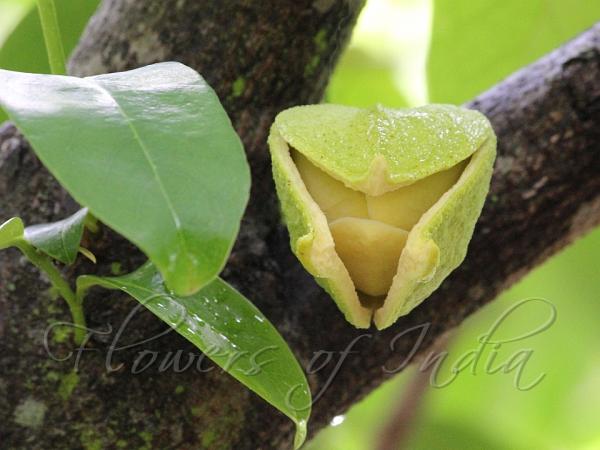|
| Soursop |
|

|

| File size | 166262 |
| Original date | |
| Resolution | 0 x 0 |
| Flash | Flash did not fire, auto |
| Focal length | 163.0mm |
| Exposure time | 1/60s |
| Aperture | 11.0 |
| Focus Distance | |
| Metering Mode | $meteringMode |
| Camera make | Canon |
| Camera model | Canon EOS 600D |
| Sensor type |
|
|
|
|
Photo: |
Botanical name: Annona muricata Family: Annonaceae (Sugar-apple family)
Synonyms: Annona macrocarpa
Synonyms: Annona macrocarpa
Soursop is a shrub or small tree 3-10 meters in
height. It is adapted to warm, humid tropical climate, and can tolerate
both drought conditions and partial shade. It grows up to 25-30 ft.
Young branchlets are rusty-hairy. The leaves, normally evergreen, are
alternate, smooth, glossy, dark green on the upper surface, lighter
beneath, oblong, elliptic or narrowobovate, pointed at both ends, 6-20
cm long and 2.5-6 cm wide. The flowers, borne singly, may emerge
anywhere on the trunk, branches or twigs. They are short stalked, 4-5
cm long, plump, and triangular-conical, the 3 fleshy, slightly
spreading, outer petals yellow-green, the 3 close-set inner petals
pale-yellow. The fruit is more or less oval or heart-shaped, some times
irregular, lopsided or curved, due to improper carper development or
insect injury. The size ranges from 10-30 cm long and up to 15 cm in
width, and the weight may be up to 4.5-6.8 kg. The fruit is compound
and covered with a reticulated, leathery-appearing but tender,
inedible, bitter skin from which protrude few or many stubby, or more
elongated and curved, soft, pliable "spines". The tips break off easily
when the fruit is fully ripe. The skin is dark-green in the immature
fruit, becoming slightly yellowish-green before the mature fruit is
soft to the touch. Its inner surface is cream-colored and granular and
separates easily from the mass of snow-white, fibrous, juicy segments
-- much like flakes of raw fish -- surrounding the central, soft-pithy
core. In aroma, the pulp is somewhat pineapple-like, but its musky,
subacid to acid flavor is unique. Soursop is native to South America,
cultivated and naturalized widely.
Medicinal uses: The seeds, fruit, and leaves have been used traditionally for stomach
complaints and fever, and as a sedative. Clinical trials are lacking
to support these uses. The most widely used preparation in traditional
medicine is the decoction of bark, root, seed or leaf and applications are
varied. In Indonesia, the Caribbean islands and South Pacific countries,
the leaves are used in bath to treat skin ailments, while in Mauritius,
New Guinea and Ecuador the application of leaves is local on the pain
site.
The seeds, fruit, and leaves have been used traditionally for stomach
complaints and fever, and as a sedative. Clinical trials are lacking
to support these uses. The most widely used preparation in traditional
medicine is the decoction of bark, root, seed or leaf and applications are
varied. In Indonesia, the Caribbean islands and South Pacific countries,
the leaves are used in bath to treat skin ailments, while in Mauritius,
New Guinea and Ecuador the application of leaves is local on the pain
site.
Medicinal uses:
 The seeds, fruit, and leaves have been used traditionally for stomach
complaints and fever, and as a sedative. Clinical trials are lacking
to support these uses. The most widely used preparation in traditional
medicine is the decoction of bark, root, seed or leaf and applications are
varied. In Indonesia, the Caribbean islands and South Pacific countries,
the leaves are used in bath to treat skin ailments, while in Mauritius,
New Guinea and Ecuador the application of leaves is local on the pain
site.
The seeds, fruit, and leaves have been used traditionally for stomach
complaints and fever, and as a sedative. Clinical trials are lacking
to support these uses. The most widely used preparation in traditional
medicine is the decoction of bark, root, seed or leaf and applications are
varied. In Indonesia, the Caribbean islands and South Pacific countries,
the leaves are used in bath to treat skin ailments, while in Mauritius,
New Guinea and Ecuador the application of leaves is local on the pain
site.
| Identification credit: S. Jeevith | Photographed in Tamil Nadu & Karnataka. |
• Is this flower misidentified? If yes,